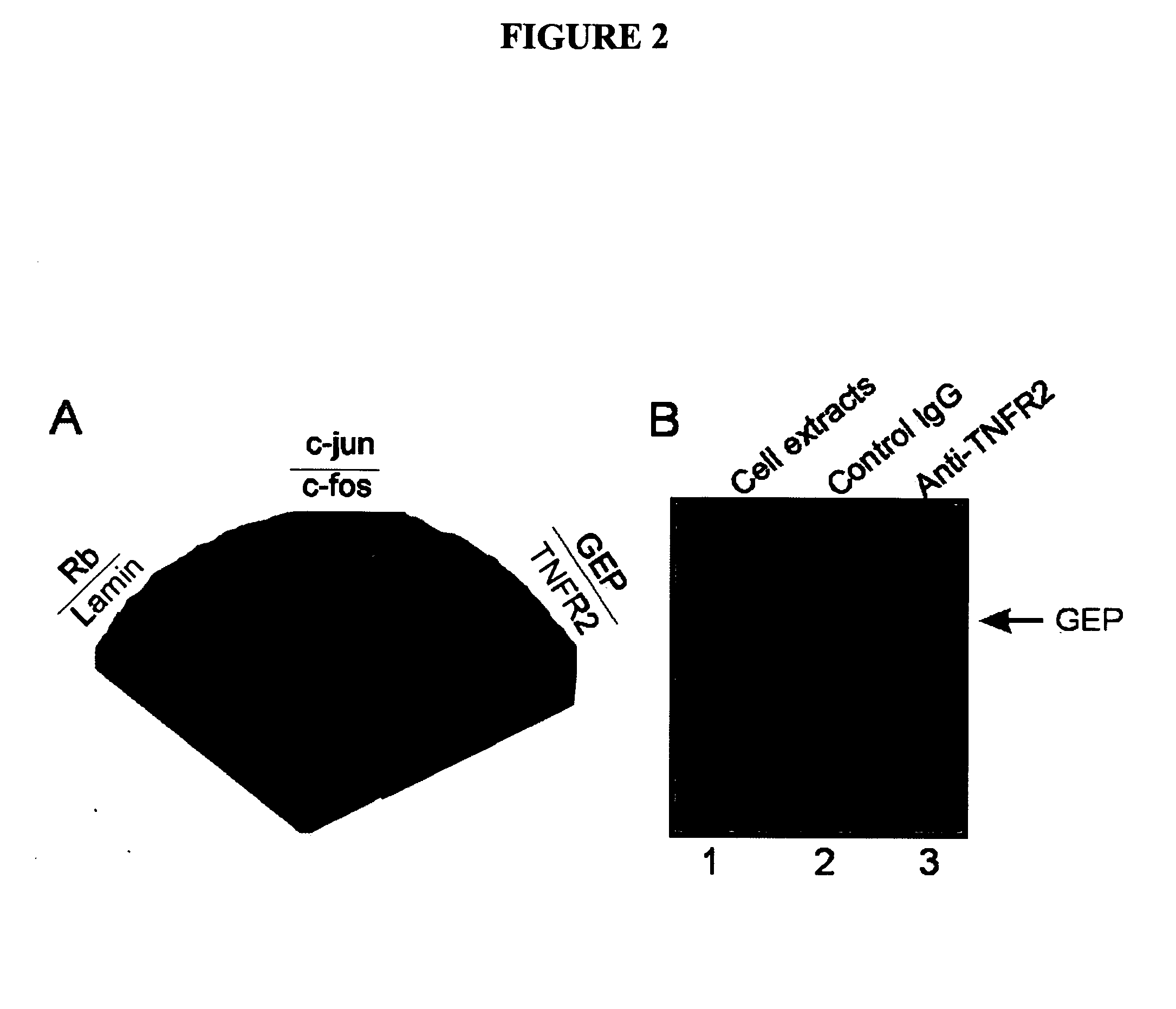Peptides targeting TNF family receptors and antagonizing TNF action, compositions, methods and uses thereof
a technology of tnf family receptors and peptides, applied in the field of peptides, can solve the problems of increased health care usage, physical disability, and out-of-date design protein/peptide therapeutic agents, and achieve the effects of reducing the number of new drugs, reducing the number of drugs, and improving the quality of li
- Summary
- Abstract
- Description
- Claims
- Application Information
AI Technical Summary
Benefits of technology
Problems solved by technology
Method used
Image
Examples
example 1
GEP Binds to and Antagonizes TNFα Receptors (TNFR)
[0172]Modern methods of global analysis of protein-protein interactions followed by biological assessment have led to powerful ways of identifying novel proteins not previously associated with the pathogenesis of a particular disease or organ system. Through a functional genetic screen, we have now discovered that GEP, a novel mediator in chondrogenesis and arthritis, associates with TNFR. This extends our understanding of the action of growth factors and cytokines in cartilage biology and their application to treatment of cartilage disorders and arthritic conditions. In particular, our studies shed light on a naturally occurring antagonist of the central proinflammatory cytokine TNFα, and provide insights into the degradative events that occur in patients with arthritic disorders. The identification and manipulation of growth factors that regulate the chondrogenic potential of mesenchymal stem cells and act as an inhibitors of a cen...
example 2
Discovery of Atsttrin (Antagonist of TNF / TNFR Signaling via Targeting TNF Receptors)
[0189]To identify the peptide(s) of GEP required for binding to TNF receptors, a series of GEP mutants (i.e. C-terminal deletions, N-terminal deletions, individual granulin unit, individual linker, as well as various combinations) were expressed in a yeast expression plasmid. Briefly, cDNA segments encoding the series of GEP mutants were amplified by PCR and cloned in-frame into the SalI / NotI sites of pDBleu (Life Technologies) yeast expression vector. The generated plasmids and pPC86-TNFR encoding extracellular domain of TNFR1 / R2 was cotransformed into the yeast MaV203 strain containing three reporter genes, His+, Ura+, and LacZ (Life Technologies), and transformants was examined for β-galactosidase. Results from filter-based β-galactosidase assays (right panel in figures FIG. 9 through FIG. 15) of all these mutants are summarized in the left panel of these figures. As revealed in FIG. 9, results fr...
example 3
GEP Antagonizes TNF Action
[0191]Atsttrin antagonizes TNFα-induced inflammation response: We next determined whether Atsttrin inhibits TNF-mediated inflammation. Neutrophils are triggered by inflammatory stimuli like TNF to generate large quantities of reactive oxygen species that contribute to neutrophil activation and the development of inflammatory processes [59]. Accordingly, we tested the effect of Atsttrin on TNFα-induced neutrophil activation. As shown in FIG. 16A, Atsttrin dose-dependently inhibits neutrophil activation triggered by TNFα. Importantly and remarkably, Atsttrin exhibits inhibition that rivals (is at least as good as) Enbrel and Remicade (FIG. 16B), which have been used clinically for treating various kinds of inflammatory diseases, including particularly rheumatoid arthritis [60].
[0192]GEP inhibits TNFα-induced cell death: TNF-α has been shown to induce apoptosis in chondrocyte cultures [61-63]. We next determined whether GEP affected TNF-α-induced apoptosis in ...
PUM
| Property | Measurement | Unit |
|---|---|---|
| Angle | aaaaa | aaaaa |
| Angle | aaaaa | aaaaa |
| Acidity | aaaaa | aaaaa |
Abstract
Description
Claims
Application Information
 Login to View More
Login to View More - R&D
- Intellectual Property
- Life Sciences
- Materials
- Tech Scout
- Unparalleled Data Quality
- Higher Quality Content
- 60% Fewer Hallucinations
Browse by: Latest US Patents, China's latest patents, Technical Efficacy Thesaurus, Application Domain, Technology Topic, Popular Technical Reports.
© 2025 PatSnap. All rights reserved.Legal|Privacy policy|Modern Slavery Act Transparency Statement|Sitemap|About US| Contact US: help@patsnap.com



